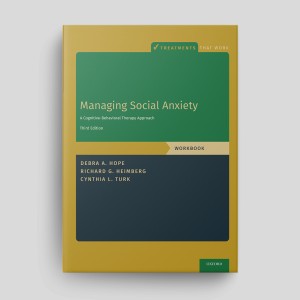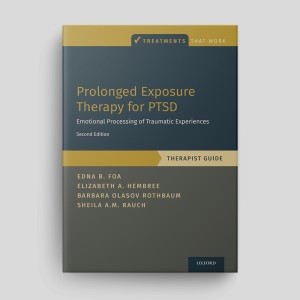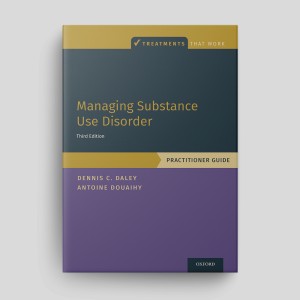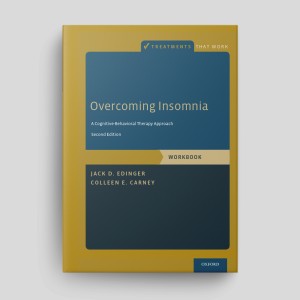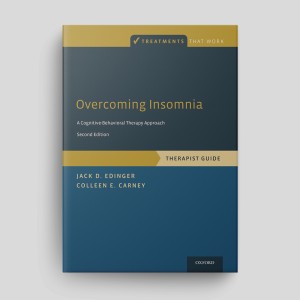Cognitive Restructuring
At the core of the cognitive model is the assumption that a patient’s appraisals of an event determine their feelings and reactions to it. Cognitive restructuring is an umbrella term that refers to any methods that help people to think differently about an event (which might include any stimulus, thought, memory, or belief). In a broad sense the term ‘cognitive restructuring’ could apply to anything done in (or outside of) a therapy session that promotes cognitive change. In a narrower sense, therapists deliberately use a range of therapeutic approaches designed to promote cognitive restructuring. Leahy and Rego (2012) give a narrow definition of cognitive restructuring as:
“a multistep process that involves: (1) eliciting problematic cognitions known as automatic thoughts or negative automatic thoughts of the self, world, or future, (2) formulating rational responses to these negative automatic thoughts by (3) identifying and removing cognitive distortions found in the automatic thoughts and (4) correcting false beliefs, assumptions, predictions and so on, using a Socratic dialogue.”
Showing 1 to 50 of 100 results
Mastery of Anxiety And Panic For Adolescents: Riding The Wave: Therapist Guide
Mastery of Anxiety And Panic For Adolescents: Riding The Wave: Therapist Guide
Managing Bipolar Disorder: Workbook
Managing Bipolar Disorder: Workbook
Managing Bipolar Disorder: Therapist Guide
Managing Bipolar Disorder: Therapist Guide
Scaling - Testing Your Assumptions
Scaling - Testing Your Assumptions
Scaling - Beliefs About Yourself
Scaling - Beliefs About Yourself
Examining Your Negative Thoughts
Examining Your Negative Thoughts
Prompts For Challenging Your Negative Thinking
Prompts For Challenging Your Negative Thinking
Unified Protocol for Transdiagnostic Treatment of Emotional Disorders (Second Edition): Client Workbook
Unified Protocol for Transdiagnostic Treatment of Emotional Disorders (Second Edition): Client Workbook
Unified Protocol for Transdiagnostic Treatment of Emotional Disorders (Second Edition): Therapist Guide
Unified Protocol for Transdiagnostic Treatment of Emotional Disorders (Second Edition): Therapist Guide
Cognitive Distortions – Unhelpful Thinking Styles (Common)
Cognitive Distortions – Unhelpful Thinking Styles (Common)
Cognitive Distortions – Unhelpful Thinking Styles (Extended)
Cognitive Distortions – Unhelpful Thinking Styles (Extended)
Disqualifying The Positive
Disqualifying The Positive
Identifying Your Demanding Standards
Identifying Your Demanding Standards
Evaluating Your Demanding Standards
Evaluating Your Demanding Standards
Mastery Of Your Anxiety And Worry (Second Edition): Workbook
Mastery Of Your Anxiety And Worry (Second Edition): Workbook
Mastery Of Your Anxiety And Worry (Second Edition): Therapist Guide
Mastery Of Your Anxiety And Worry (Second Edition): Therapist Guide
Managing Social Anxiety (Third Edition): Workbook
Managing Social Anxiety (Third Edition): Workbook
Managing Social Anxiety (Third Edition): Therapist Guide
Managing Social Anxiety (Third Edition): Therapist Guide
Reclaiming Your Life From A Traumatic Experience (Second Edition): Workbook
Reclaiming Your Life From A Traumatic Experience (Second Edition): Workbook
Prolonged Exposure Therapy For PTSD (Second Edition): Therapist Guide
Prolonged Exposure Therapy For PTSD (Second Edition): Therapist Guide
Treating Your OCD With Exposure And Response (Ritual) Prevention (Second Edition): Workbook
Treating Your OCD With Exposure And Response (Ritual) Prevention (Second Edition): Workbook
Overcoming Eating Disorders (Second Edition): Therapist Guide
Overcoming Eating Disorders (Second Edition): Therapist Guide
Managing Substance Use Disorder (Third Edition): Practitioner Guide
Managing Substance Use Disorder (Third Edition): Practitioner Guide
Overcoming Depression (Second Edition): Workbook
Overcoming Depression (Second Edition): Workbook
Overcoming Depression (Second Edition): Therapist Guide
Overcoming Depression (Second Edition): Therapist Guide
Overcoming Insomnia (Second Edition): Workbook
Overcoming Insomnia (Second Edition): Workbook
Overcoming Insomnia (Second Edition): Therapist Guide
Overcoming Insomnia (Second Edition): Therapist Guide
Mastery Of Your Anxiety And Panic (Fifth Edition): Workbook
Mastery Of Your Anxiety And Panic (Fifth Edition): Workbook
Mastery Of Your Anxiety And Panic (Fifth Edition): Therapist Guide
Mastery Of Your Anxiety And Panic (Fifth Edition): Therapist Guide
Thought Record – Courtroom Trial
Thought Record – Courtroom Trial
Links to external resources
Psychology Tools makes every effort to check external links and review their content. However, we are not responsible for the quality or content of external links and cannot guarantee that these links will work all of the time.
Information Handouts
-
Unhelpful Thinking Styles (Information Handouts)
| Centre For Clinical Interventions
- Mental Filter
- Jumping To Conclusions
- Personalisation
- Catastrophizing
- Black And White Thinking
- Shoulding And Musting
- Overgeneralization
- Labelling
- Emotional Reasoning
- Magnification And Minimisation
- Challenging Unhelpful Thinking Styles
Information (Professional)
- Definition of cognitive restructuring | Marks, I., Borgo, S., and Sibilia, B.
- Modification of core beliefs in cognitive therapy | Wenzel
Websites
-
Cognitive Restructuring resources from Psychodelights.com
- Identifying and Challenging Thinking Errors
- Identifying and Modifying Negative Automatic Thoughts
- Identifying and Working With Dysfunctional Assumptions
Recommended Reading
- Schema change processes in cognitive therapy | Padesky | 1994
- Bouchard, S., Gauthier, J., Laberge, B., French, D., Pelletier, M. H., & Godbout, C. (1996). Exposure versus cognitive restructuring in the treatment of panic disorder with agoraphobia.Behaviour Research and Therapy,34(3), 213-224.
- Bryant, R. A., Moulds, M. L., Guthrie, R. M., Dang, S. T., & Nixon, R. D. (2003). Imaginal exposure alone and imaginal exposure with cognitive restructuring in treatment of posttraumatic stress disorder.Journal of consulting and clinical psychology,71(4), 706. archive.org
What Is Cognitive Restructuring?
Techniques for Cognitive Restructuring
Behavioral experiments (including hypothesis testing and surveys) have been a fundamental CBT technique since the publication of the first treatment manual: “a powerful method with which to investigate the validity of a specific assumption consists of designing an experiment or task to test the assumption empirically” (Beck et al., 1979). Bennett-Levy et al. (2004) define behavioral experiments as:
“planned experiential activities, based on experimentation or observation, which are undertaken by patients in or between cognitive therapy sessions … their primary purpose is to obtain new information which may help to: test the validity of the patients’ existing beliefs …; construct and/or test new, more adaptive beliefs; contribute to the development and verification of the cognitive formulation.”
Examining and reality-testing automatic thoughts and images, popularly known as ‘thought challenging’ or ‘disputing thoughts’ is a technique by which patients are encouraged to examine the accuracy of and validity of their negative automatic thoughts and images.
Psychoeducation in therapy refers to information-giving. Many patients experience psychological distress because they lack critical information. Information can be given directly in the form of handouts or reading, or indirectly in the form of information-gathering exercises.
Socratic dialogue is “a method of guided discovery in which the therapist asks a series of carefully sequenced questions to help define problems, assist in the identification of thoughts and beliefs, examine the meaning of events, or assess the ramifications of particular thoughts or behaviors” (Beck & Dozois, 2011). The Socratic method can help patients to reflect upon how they think and the assumptions they make, and can promote cognitive change.
References
Beck, A. T., & Dozois, D. J. (2011). Cognitive therapy: Current status and future directions. Annual Review of Medicine, 62, 397–409.
Beck, A. T., Rush, A. J., Shaw, B. F., & Emery, G. (1979). Cognitive therapy of depression. New York: Guilford Press.
Bennett-Levy, J., Butler, G., Fennell, M., Hackmann, A., Mueller, M., & Westbrook, D. (2004). Oxford guide to behaviouralexperiments in cognitive therapy. New York: Oxford University Press.
Leahy, R. L., & Rego, S. A. (2012). Cognitive restructuring. In W. T. O’Donohue & J. E. Fisher (Eds.), Cognitive behavior therapy: Core principles for practice(pp. 113–158). Hoboken, NJ: Wiley.




































